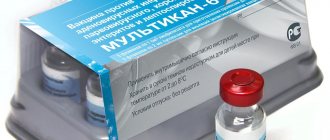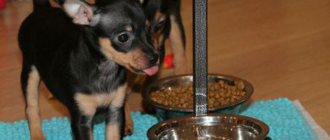Parvovirus enteritis in dogs - they began to suffer from it relatively recently. Only in 1978 did the first outbreaks of the epidemic appear. And, despite the fact that this virus was very similar to the enteritis of minks and the panleukopenia that suffered from cats, its nature was very different from these varieties.
But the disease itself is dangerous. Since ignoring the problem can lead to the death of the animal. In this case, the dog begins to dry out before our eyes. To avoid this, you need to contact a veterinarian, but first know what kind of disease it is.
The causative agent of infection
The disease in four-legged pets is caused by Canine parvovirus (CPV), or canine parvovirus. It is divided into 2 types:
- CPV-1 is a harmless type of pathogen that causes mild diarrhea in young animals;
- CPV-2 is a pathogenic and highly contagious strain that undermines the functioning of internal organs and often causes death in animals under 2 months of age.
The main feature of CPV is its high resistance to environmental factors. It is not afraid of sub-zero temperatures and is difficult to heat and disinfect. The virus retains its pathogenicity for up to 2 years, being outside a living organism and in a humid environment, protected from exposure to the sun, and when heated to 80°C it dies only in the 15th minute. To neutralize CPV at home, formaldehyde and chloride solutions are used.
Mechanism of infection and spread of the virus
Infection occurs by inhalation or ingestion of the pathogen, that is, through the respiratory system or digestive tract. Once in the animal's body, CPV penetrates actively dividing cells. This property is characteristic of the lymph nodes, heart and epithelial tissue of the small intestine.
Along with the division of its own cells, the body generates more and more viruses. On day 3, the invaders enter the bloodstream and spread throughout the body. Some of them come out along with feces, spreading the disease further.
The toxins produced by CPV affect the functionality of the affected organs and undermine the immune system. Because of this, a viral infection is often complicated by a bacterial one.
CANINE PARVOVIRUS
views
Author: Nicola Decaro, DVM, PhD
Department of Veterinary Medicine, University of Bari, Valenzano, Italy
The article was prepared based on materials from the journal VETERINARY FOCUS26.1, 2016, “Neonatology and Pediatrics”
Introduction
Canine parvovirus is the leading cause of severe gastroenteritis in puppies 1 to 6 months of age. Although this virus has been known since the late 1970s, it still poses a major threat to young dogs due to the severity of clinical symptoms and because maternal antibodies (MA) can interfere with active immunization and can negatively affect the vaccination program.
Canine parvovirus (CPV) is a small non-enveloped virus (Figure 1) with a spherical capsid (composed of three proteins, VP1, VP2 and VP3) containing linear single-stranded DNA encoding two non-structural (NS1 and NS2) and two structural (VP1 and VP2) ) squirrel. VP2 is the major capsid protein and is a viral antigen (1, 2). A recent revision of the nomenclature of the parvovirus family (Parvoviridae) resulted in CPV being recognized as a separate species, Carnivore protoparvovirus 1, along with feline panleukopenia virus (FPLV) and other related carnivore parvoviruses.
Another obstacle to disease control is the circulation of field variants (CPV-2a, CPV-2b, CPV-2c), which are antigenically different from the original CPV 2 strain still contained in most commercial vaccines. There are only a few amino acid differences between CPV-2 and its antigenic variants, but there is speculation that vaccination may provide only partial protection, exposing animals to the risk of infection with field strains and development of disease.
Current issues to be addressed are the increased incidence of the disease in adult dogs and the ability of antigenic variants to infect cats, causing clinical symptoms identical to feline panleukopenia. This article focuses on the clinical, pathological and diagnostic aspects of CPV infection, with a summary of the current epidemiological situation in different countries and an overview of recommended vaccination protocols.
Key points
- Canine parvovirus is the leading cause of acute gastroenteritis in young puppies and occurs worldwide.
- Three antigenic variants completely replaced the original strain; their prevalence is heterogeneous and depends on the geographic region.
- Typical clinical symptoms include vomiting, bloody diarrhea, and leukopenia; The mortality rate in infected kennels and dog shelters can reach 60-70%.
- In-clinic diagnostic tests have poor sensitivity and additional testing using PCR-based methods may be required.
- Treatment is primarily supportive care, although several antiviral drugs have been tested.
- Vaccination of puppies remains the most effective strategy for infection control, despite possible interference from maternal antibodies and the presumed mismatch between vaccine and field strains.
Epidemiology
The original strain of CPV-2 emerged in the late 1970s and was likely a variant strain of FPLV that had previously mutated in an unidentified species of wild carnivore. In the early 1980s, the original virus was suddenly replaced by two antigenic variants, CPV-2a and CPV-2b, generated by 5 or 6 amino acid substitutions in the VP2 capsid protein, and a third variant, CPV-2c, was noted in Italy in 2000 G.
Currently, the original strain of CPV-2, still used in most vaccines, is no longer circulating in the field, while its three antigenic variants are distributed unevenly around the world. In continental Europe, the variants appear to circulate together, with a predominance of types 2a and 2b in Portugal, France and Belgium, types 2a and 2c in Italy, type 2a in Eastern Europe and type 2c in the Iberian Peninsula, and in Germany all are equally common three variants of the virus. In North and South America, frequent occurrence of CPV-2b/2c and CPV-2a/2c has been identified, respectively; in Asia and in island countries such as the UK, Australia and Japan, types 2a and 2b are predominant. The few reports from Africa indicate co-circulation of the three strains in the north of the continent and high occurrence of CPV-2a and 2b in the south.
CPV can infect domestic dogs, as well as wolves and other wild carnivore species, which often produce viruses intermediate between CPV-2 and CPV-2a. The original CPV-2 strain could infect feline cells in vitro but not in vivo; in contrast, new antigenic variants can infect cats, causing a disease indistinguishable from feline panleukopenia. Theoretically, there is no predisposition to CPV infection. Large breeds such as the German Shepherd, Labrador Retriever, Rottweiler, Alaskan Malamute and Doberman Pinscher appear to be at increased risk, but this may be due to the fact that MA levels in rapidly growing large breed puppies decline faster than in smaller dogs. Additionally, although CPV infection and associated illness primarily occur in puppies younger than 6 months of age, there has been an increasing incidence of severe clinical signs in adult dogs, often caused by CPV-2c infection.
The feces of infected puppies are a major source of virus in the environment; The virus is extremely persistent and can remain contagious for weeks or even months. Puppies that have not received drug therapy become infected through the oronasal route through direct or indirect contact.
Pathogenesis
The target tissues for viral replication are the intestinal crypts and lymphoid organs, but the virus can spread to all tissues. Once ingested, CPV primarily replicates in the lymphoid tissue of the oropharynx, thymus, mesenteric lymph nodes, and Peyer's patches, causing widespread necrosis before spreading into the bloodstream, usually via infected lymphocytes. Viremia is long-lasting (the virus can be detected for up to 60 days by real-time PCR) and leads to colonization of the crypts of the small intestine, where active viral replication causes rapid lysis of stem cells. The direct consequence is a disruption in the renewal of epithelial cells of the intestinal villi, leading to diarrhea. Isolation of the virus in feces begins 2-3 days after infection and lasts up to 45-50 days, but high titers can be obtained only in the first 7-10 days. In newborn puppies (under 2–3 weeks of age), CPV is capable of multiplying in actively dividing myocardial cells, causing severe myocarditis, although such cases currently occur only occasionally. Compared to the original type 2 strain, antigenic variants are characterized by higher pathogenicity, a shorter incubation period (less than 4-5 days), more severe clinical symptoms, a higher level and duration of virus shedding, and a lower concentration of virus required for infection dogs. Associated infection with canine coronavirus (CCoV) can worsen clinical signs, with CPV and CCoV infecting the crypt and villous epithelium of the intestine, respectively.
Clinical symptoms and pathology
As stated above, the incubation period of the original CPV-2 strain lasted up to 7 days, while new variants usually take only 3-4 days to show clinical symptoms. Depending on the age and immune status of the infected dog, CPV infection can take various clinical forms, ranging from asymptomatic infection to acute gastroenteritis and (extremely rarely) myocarditis.
Asymptomatic infections
Asymptomatic infections usually occur in puppies with intermediate levels of maternal antibodies (haemagglutination inhibition antibody titers ranging between 1:20 and 1:80), protecting against overt disease but not infection. Differences in maternal antibody levels between puppies of the same litter may explain why some puppies exhibit severe clinical disease while others show few or no clinical signs. Adult dogs can also be infected with some clinical symptoms or asymptomatic due to the greater maturity of the intestinal mucosa. Sometimes only vague symptoms are observed, for example, lethargy and loss of appetite for 2-3 days, along with moderate transient leukopenia. Asymptomatic infections are of particular importance in animal shelters and kennels, where the presence of healthy but infected animals may facilitate transmission of the virus to other puppies.
Gastroenteric form
This is the most common form caused by CPV infection in puppies between one and six months of age, although there is growing evidence of the disease in adult dogs. After 3-4 days of incubation, puppies develop anorexia, depression and vomiting followed by diarrhea leading to severe dehydration. Diarrhea is often, although not always, bloody, with stool streaked with blood or dark in color due to blood. Fever (40-41°C) may be present but does not occur in all cases. Leukopenia, on the other hand, is common, with a decrease in white blood cell count (WBC) below 2000-3000 cells/μl. It should be noted that the absolute white blood cell count may be normal in the case of viral leukopenia with concomitant neutrophilia caused by an opportunistic bacterial infection. These bacteria often intensify the clinical course of the disease, causing additional symptoms leading to the death of the animal, such as respiratory depression. The degree of leukopenia is determined as a prognostic factor; It is noted that puppies with white blood cell levels below 1000 cells/μl have an extremely low chance of survival. Death may occur as early as two days after the onset of clinical symptoms due to bacterial dissemination or disseminated intravascular coagulation. Mortality rates can vary greatly depending on the age and immune status of the animal; The mortality rate in adult dogs is usually less than 1%.
Puppies that die from parvovirus enteritis are extremely dehydrated. At autopsy, extensive lesions of the gastrointestinal tract are visible, mainly covering the duodenum and then the jejunum. The most common is hemorrhagic gastroenteritis; the intestinal wall is usually thickened, with pale patches, and the serosal surface may be dark red or purple, sometimes covered with fibrin. The intestines may be empty or contain a dark (often bloody) mass or hemorrhagic fluid. Mesenteric lymph nodes and Peyer's patches are enlarged, swollen, often with multiple hemorrhages on the cortex and on the cut surface (Figure 3). Histopathology of the small intestine shows multifocal crypt necrosis and intranuclear inclusion bodies, and extensive lymphocyte depletion is observed in Peyer's patches, lymph nodes, spleen, and thymus. With the development of bacterial complications, pulmonary edema and alveolitis may occur.
Myocardial form
Acute myocarditis was common during the first worldwide outbreak of CPV when infection affected a population of dogs not previously exposed to the virus, but to date this form has only been encountered sporadically in the field. In fact, parvovirus myocarditis can only develop in puppies younger than 3-4 weeks, when the myocardial syncytium is actively dividing and is not protected from viral replication. However, today, because most bitches have been vaccinated (or exposed to the virus) and have developed a strong immunity, virtually all puppies receive maternal antibodies that protect them from parvovirus infection in the first weeks of life.
Parvoviral myocarditis is characterized by the sudden death of infected puppies. In some cases, death is preceded by gastrointestinal symptoms and brief episodes of dyspnea, vocalizations, and vomiting. Some animals may be clinically healthy and heart pathology will only be clearly visible on an electrocardiogram; in this situation, the virus predisposes the dog to develop degenerative heart disease, and heart failure may develop weeks or months later. Puppies recovering from parvovirus myocarditis develop myocardial fibrosis. Dogs that died from the myocardial form of the disease were often in good shape, and sometimes the only finding at necropsy was pulmonary edema. In other cases, there is flabbiness of the walls and dilatation of the chambers of the affected heart, with pale foci of necrosis on the surface. Histopathologically, myocardial lesions include nonsuppurative myocarditis, multifocal infiltration of lymphocytes and plasma cells, and the presence of intranuclear inclusion bodies.
Diagnostic approach
Diagnosis of CPV infection is often based simply on the presence of foul-smelling and bloody diarrhea, but it should be emphasized that other pathogens may present with similar symptoms and that parvovirus enteritis often occurs without hemorrhage. Thus, laboratory diagnosis is required in all cases to either confirm or rule out CPV infection.
Clinical diagnosis
Vomiting and bloody diarrhea accompanied by acute leukopenia strongly suggests CPV infection. However, the differential diagnosis also includes canine distemper, infectious canine hepatitis, intestinal parasitosis and other nutritional disorders. CCoV (Canine Coronavirus) usually causes enteritis without bleeding, but under some conditions the pathogen can cause bloody diarrhea, and highly virulent strains (pantropic CCoV) can cause systemic disease and leukopenia.
Virological diagnostics
Direct detection of the virus can be carried out on the feces of sick dogs, or on tissues at autopsy (intestines, spleen, lymph nodes). In later stages of infection, blood will be the most reliable sample due to prolonged viremia. High levels of virus are detected in all tissues, including the brain, although the highest titers are found in lymphoid tissues.
A number of commercial in-clinical test kits are available for the detection of CPV in stool. These tests detect (with equal efficiency) all three antigenic variants and even the related feline panleukopenia virus. However, they have low sensitivity, missing up to 50-60% of CPV-positive samples, especially in late stages of infection when the virus is excreted in the feces in small quantities, and/or in cases where high titers of CPV antibodies in the intestinal lumen suppress the production of viable virus . The hemagglutination (HA) test and virus isolation can only be performed in specialized laboratories and does not provide significantly higher sensitivity than in-clinic testing.
However, PCR-based methods that detect viral DNA are highly sensitive and should be used at least when parvovirus is strongly suspected but in-clinic testing of the puppy is negative. In addition, PCR tests have been designed to distinguish CPV variants as well as vaccine viruses from field viruses, which may be useful in resolving disputes between owners, veterinarians and vaccine manufacturers when diarrhea occurs in a dog several days after vaccination against CPV. Indeed, commercially available vaccines contain modified live viruses that replicate in the intestinal epithelium of vaccinated dogs: the virus is excreted in the feces (albeit in low titers and for a shorter period of time than field strains), which can lead to the detection of CPV in the feces of vaccinated dogs dogs and misdiagnosis when clinical symptoms are actually caused by other enteropathogens. Moreover, PCR analysis may be useful in dispelling speculation about the development of virulence in the vaccine strain if the animal develops acute gastroenteritis shortly after vaccination.
Serological diagnosis
Although a number of tests are available, serological testing does not provide diagnostic value. In fact, specific antibodies in the serum may not be associated with an active CPV infection if the dog has been previously vaccinated against or has previously been exposed to the virus. However, serological testing is useful for assessing the dog's immunological status for CPV before and after vaccination, and for assessing the decline in maternal antibody levels to calculate when a puppy can be vaccinated against CPV without maternal antibody interference. A serological test is also important to determine whether the dog has responded to the vaccination. The most common type of serological test is the hemagglutination inhibition (HI) test, which requires trained personnel and special substrates, but only the virus neutralization (VN) test can detect protective antibodies and is widely used to assess cross-neutralization of vaccine and field virus.
Therapeutic approach
Despite the supportive and nonspecific nature of therapy, it often has a beneficial effect on mortality in CPV infection. The main goal of therapy for parvovirus enteritis is to restore fluid levels and water-electrolyte balance, as well as to prevent the development of concomitant infection with opportunistic bacteria. Intravenous infusion therapy with Ringer's solution with the addition of glucose and potassium neutralizes hypoglycemia and hypokalemia. In the absence of regular monitoring of electrolytes and serum glucose levels, empirical addition of IV fluids with potassium chloride (20-40 mEq/L) and dextrose (2.5-5%) is adequate.
Parenteral antiemetics (eg, chlorpromazine, acepromazine, prochlorperazine, metoclopramide, ondansetron, dolasetron, and maropitant) may help reduce fluid loss and stress in the patient, making enteral nutrition easier. However, note that α-blockers may increase hypotension in hypovolemic puppies, while prokinetics may increase the risk of intussusception. Gastroprotective agents and histamine H2 receptor blockers (cimetidine, ranitidine) may also have a beneficial effect.
Broad-spectrum antimicrobials should be administered to prevent or treat secondary infections. To control gram-negative aerobic and anaerobic bacterial infections, which often cause complications in canine parvovirus, it is best to use a combination of penicillin and aminoglycoside antibiotics.
For patients with nephropathy, third-generation cephalosporins are preferred over nephrotoxic aminoglycosides, and quinolones should be avoided in growing dogs. If vomiting has stopped for 12-24 hours, it is not recommended to prevent the sick puppy from consuming food and water, as there is evidence that animals fed easily digestible commercial or homemade food recover more quickly. Puppies with anorexia should be fed an appropriate diet through a nasal-esophageal or nasal-gastric tube.
Transfusions of whole blood or plasma can help compensate for the loss of blood and protein caused by severe enteritis. No drug has been found to be effective against CPV infection.
Administration of hyperimmune plasma or purified immunoglobulins may be useful as a prophylactic measure for puppies exposed to infected animals, but there is no evidence that such therapy is effective in affected puppies. In reality, by the time clinical symptoms manifest, the virus has already colonized the target tissues and antibody levels are already high. Molecules that stimulate leukocyte synthesis, such as recombinant human or canine granulocyte colony-stimulating factor, have been reported to reduce length of hospitalization and improve survival, but further studies are needed to confirm their effectiveness.
In recent years, a number of antiviral drugs have been tested for effectiveness against CPV infection: the anti-influenza drug oseltamivir may be effective, but further research is needed. Studies have shown that recombinant feline interferons reduced the severity of clinical symptoms and mortality only if treatment was started as soon as possible after infection - a condition that was not reproduced in the real world.
Control
Although test results support continued shedding of infectious virus in the stool, it is unlikely that it will be shed for more than 7 to 10 days. However, due to the absence of an envelope, the virus is extremely resilient, making it difficult to destroy in the environment, where it can persist for several weeks or months, leading to further spread of infection.
Strict isolation of infected puppies and thorough disinfection are required. Feces should be removed as quickly as possible, since they are the main source of viral contamination of the environment.
Most common disinfectants are unable to inactivate CPV, but a 5-10% sodium hypochlorite solution has been shown to be effective. All surfaces that can withstand the treatment should be soaked in a bleach solution for at least 10 minutes, especially kennels and hospital cages that are heavily contaminated with feces. Surfaces that cannot tolerate bleach should be decontaminated with steam.
Vaccination
Interference of maternal antibodies
The main problem with CPV vaccination is maternal antibodies, which protect puppies from infection with field strains but interfere with active immunization. Maternal antibody titers depend on the level of antibodies in the mother's blood serum and the volume of colostrum consumed by the puppies. Accordingly, puppies from the same dam may have different levels of maternal antibodies and therefore may be susceptible to CPV infection (and active immunization) at different ages. Vaccination of puppies with high levels of maternal antibodies (HI titers > 1:20) may result in failure of seroconversion due to destruction of the vaccine virus by colostral antibodies. Since only HI titres > 1:80 are considered protective against infection by field strains, there is a so-called “window of susceptibility” - a period, usually lasting 2-3 weeks, during which puppies cannot be vaccinated, but they can become infected and subsequently develop the disease .
To prevent interference with active immunization, vaccines should be administered to puppies only after maternal antibodies have disappeared. Various vaccination strategies have been recommended to overcome maternal antibody interference, including high titer vaccines and intranasal vaccination. Repeated intranasal administration of monovalent CPV vaccines was effective in eliminating the virus in infected nurseries (personal observation).
According to the recommendations of the World Association of Small Animal Veterinary Medicine, the course of primary vaccination against CPV should not end before reaching 14-16 weeks of age to provide protection even to puppies with long-lasting maternal antibodies. The recommended protocol includes three doses of CPV vaccine in the first year of life and a booster dose after one year, followed by a booster dose every three years.
CPV-2 vaccines and cross-protection against antigenic variants
Although the window of susceptibility is the main reason for the active circulation of CPV among vaccinated animals, there are also doubts about the full effectiveness of type 2 CPV vaccines against new antigenic variants of the virus. Most commercial vaccines are prepared using an older strain of CPV-2 that is no longer circulating in nature, and research has confirmed the inability of antibodies raised against the vaccine virus to completely neutralize field strains of CPV. There are several licensed vaccines containing the CPV-2b variant, and it would be desirable to have vaccine products containing the new 2c variant, although the three variants are capable of effective cross-neutralization of each other.
Share
Causes of the disease
The main cause of the disease is direct or indirect contact with an infected or recently ill animal. The release of the virus into the external environment continues even after recovery.
Routes of infection
The disease is transmitted in 2 ways: contact and fecal-oral. In addition to interaction with the patient or his personal belongings, the danger is posed by contaminated water, food, soil, and even the owner himself, who brought the virus into the house on his shoes.
Risk group
Parvovirus infection in puppies born from an unvaccinated mother is most severe. They do not receive antibodies through breast milk and lack passive immunity that protects until the first vaccination.
Also at risk are older dogs and pets with chronic pathologies that weaken the immune response. The likelihood of infection increases with helminthiasis, frequent stress, unbalanced feeding and crowded housing. CPV is often diagnosed in animals adopted from shelters.
Prevention
Since the virus is transmitted from one dog to another, you should not walk your pet in places where unvaccinated dogs walk.
Before the exhibition, all dogs are kept in quarantine. The period is 30 days. And pets are allowed to participate in such exhibitions when the owners have documents in their hands indicating a good state of health and the presence of all necessary vaccinations (including against parvovirus enteritis).
The dog must be kept clean. Regular disinfection of premises and organized feeding reduces the risk of infection with an infectious agent. To do this, use a 2% or 3% sodium solution. Sodium hydroxide or formaldehyde may also be used.
All puppies must be vaccinated according to the vaccination schedule. If it turns out that the dog is sick, it is isolated, and the room is treated with disinfectant solutions daily. You can prevent it by strengthening your pet's immune system. To do this, you need to add all the necessary minerals and vitamins to your dog’s diet.
Prognosis for recovery
The prognosis for the patient depends on his age and the course of the pathology. The highest mortality rate occurs among puppies with myocarditis.
In puppies
The probability of death with the intestinal form varies from 25 to 50%. Despite this scatter, the data for the cardiac form are much worse and amount to 70-90%.
A more accurate prognosis is given on the 4th day after the first symptoms of parvovirus appear in the puppy. If by this time the condition remains stable and does not worsen, then the baby is on the mend. The immune system begins to actively produce antibodies to neutralize the virus and ultimately wins. After recovery, the immune response against the pathogen lasts up to 3 years.
In adult dogs
Mortality from the cardiac form in adult animals is not very different from young animals and is 70-80%. But the prognosis for the intestinal form of the disease is much more optimistic. The probability of death is reduced to 5-10%.
With a mild course and strong immunity, patients recover on their own within 1-3 days, and with more severe cases, with the help of medication, after 3-5 days. An unfavorable outcome is observed only in those who came to the veterinarian too late and suffered from dehydration and exhaustion for a long time.
Animals at risk
Both adults and puppies can get hemorrhagic enteritis. However, puppies aged from one to two and a half months are considered at risk. Also, the age category of animals from two months to a year is particularly vulnerable.
If a dog does not eat properly, is often stressed, has recently undergone surgery, suffers from frequent gastrointestinal disorders, or has a helminthic infestation, the percentage of it getting enteritis increases significantly.
"Important! Veterinarians say that susceptibility to the disease does not depend on belonging to a particular breed. It is also noted that a dog that has had enteritis once becomes immune to the disease for the rest of its life, but there is no direct evidence for this theory.”
Consequences of the disease
In addition to death, you should be wary of other complications that develop during illness or shortly after recovery. These include:
- developmental delays in children who have recovered from the disease;
- polyps in the oral cavity, treated exclusively by surgery;
- secondary infections that provoke the development of alveolitis and pulmonary edema;
- acute heart failure;
- temporary or permanent loss of reproductive function;
- development of lameness;
- leukopenia, which increases vulnerability to pathogenic microorganisms.
Some animals die not from the disease itself, but from its consequences. For this reason, prevention and treatment should not be neglected even with mild symptoms.
Symptoms of different forms of flow
The first symptoms of parvovirus infection in dogs appear after the end of the incubation period, that is, 3-10 days after infection. Please note that the absence of characteristic signs of the disease does not affect the infectiousness of the sick person. He still remains dangerous to other four-legged pets, so it is recommended to isolate him at any suspicion.
Enteritis (intestinal)
The severity of symptoms depends on the number of viruses that have entered the body and age. Four-legged pets under 1 year of age usually suffer from the disease in acute and hyperacute forms. When enteritis develops, they experience the following symptoms:
- lethargy, apathy, poor appetite;
- lack of interest in water and difficulty urinating (a sick baby almost does not pee);
- repeated vomiting of pieces of semi-digested food or yellow mucus;
- watery mucous diarrhea of a yellowish-gray color with blood particles and a foul odor (due to frequent urges, the pet can walk directly under itself);
- the appearance of cracks on the nose, dry mucous membranes and skin;
- Temperature fluctuations decrease with severe dehydration and increase with leukopenia, that is, with the loss of leukocytes.
In animals with strong immunity, digestion is restored on its own in 3-4 days without taking medications. This feature distinguishes the intestinal variety from the cardiac type, in which the lack of treatment can lead to death even for a completely healthy dog.
Myocarditis (cardiac)
Myocarditis most often develops in newborns whose mothers did not receive timely vaccinations. When the heart is affected by parvovirus, a dog will experience the following symptoms:
- abnormal heart rate;
- weakening or increased heart rate;
- the appearance of foam from the nose and mouth;
- severe weakness that prevents independent breastfeeding;
- the occurrence of shortness of breath;
- blue or pale mucous membranes.
Sick children left without medical care die within 24 hours. The body of adult animals fights a little longer, but it is not able to overcome the disease on its own.
How is parvovirus enteritis treated?
Dogs infected with parvovirus usually require hospitalization in an infectious diseases hospital under the constant supervision of veterinarians to undergo treatment, which includes drips (intravenous administration of electrolyte solutions), antiemetic drugs and antibiotics. Your veterinarian will likely ask you to continue giving your pet oral antibiotics after hospitalization until he or she is fully recovered to help your weakened dog fight off secondary bacterial infections.
As mentioned, it is important to seek medical attention as soon as possible if you suspect your dog has contracted parvovirus. Dr. Mitchell writes that with proper and timely care, 68 to 92 percent of infected dogs survive. She also says that puppies that survive the first three to four days of illness usually make a full recovery.
Diagnosis at the veterinarian
Due to the high likelihood of death, a pet showing signs of illness should be scheduled for examination as soon as possible. To make a diagnosis use:
- ELISA (enzyme-linked immunosorbent assay), which detects the presence of antibodies to the pathogen;
- ICA (immunochromatographic analysis) is an analogue of ELISA, characterized by less accuracy but faster results;
- PCR analysis (polymerase chain reaction), which determines the presence of the direct pathogen using DNA fragments shortly after infection.
The ICA express test takes only 10-15 minutes, so it is based on this that a preliminary treatment plan is drawn up. Adjustments are made after receiving the results of ELISA and PCR analysis.
Also, the four-legged patient must undergo general and biochemical blood tests. With their help, the level of leukocytes and the degree of damage to internal organs are determined.
Diagnostic measures
When a dog is brought to the veterinary clinic with suspected parvovirus enteritis, the veterinarian immediately conducts a preliminary diagnosis, including a rapid test for parvovirus enteritis in dogs to make an accurate diagnosis.
The primary and main symptoms of parvovirus are sudden onset of diarrhea mixed with blood, vomiting and dehydration of the body. Also, an infectious disease often leads to enlargement of the mesenteric lymph nodes, which is detected during palpation examination.
To confirm the presence of parvovirus enteritis in a dog, the doctor conducts a number of diagnostic tests, presented:
- Using the PCR method. It allows you to detect parvovirus in the animal’s feces, which led to the development of the disease.
- RGTA. A test to identify parvovirus.
- Electron microscopy. The diagnostic technique is aimed at studying the feces of a sick animal.
- ELISA (rapid test). This enzyme immunoassay is considered the most informative and reliable method for diagnosing parvovirus enteritis in dogs.
However, the above differential methods are also important for accurately diagnosing the disease. They help distinguish parvovirus from other types of enteritis, which may be caused by bacteria or toxins.
Therapeutic measures
Drug treatment for parvovirus infection in dogs is aimed at containing the pathogen and maintaining the patient’s body. Its duration is 5 days. During this time, thanks to medications, it is possible to remove accumulated toxins, stop diarrhea and vomiting, prevent dehydration, and normalize the functioning of the heart and intestines.
All drugs are injected under the skin, into a vein or into a muscle to avoid new attacks of nausea. Animals in serious condition receive blood transfusions.
First aid at home
If you are unable to see a doctor within the next couple of hours, give your pet first aid. Put your dog on a starvation diet and do not give him water. To avoid dehydration, give a subcutaneous drip of Ringer-Locke solution or normal saline.
The discomfort of diarrhea can be relieved with Vaseline oil. Lubricate the anus and rectum with it, but do not give it inside. During vomiting, any oral administration of drugs will only aggravate the patient's condition.
Eliminating the pathogen
At an early stage (no more than 3 days from the moment of infection), the disease is suppressed with serum containing ready-made antibodies and antiviral drugs. These medications increase the body's resistance, stimulate the functioning of immune cells and disrupt the replication of parvoviruses.
Replenishment of fluids and nutrients
Infusion therapy is prescribed until vomiting stops. Until this moment, the four-legged pet cannot eat or drink on its own, so all nutrients and liquids are administered to it through a dropper.
Taking symptomatic medications
Symptomatic medications are selected individually, based on the overall picture. The animal may be prescribed:
- adsorbents that eliminate the effects of intoxication;
- antiemetic and antidiarrheal;
- hemostatic agents that increase blood clotting;
- antibiotics that destroy secondary infection;
- vasopressors and cardiotonics that combat the symptoms of myocarditis.
Treatment for parvovirus in puppies and adults differs in dosage. For this reason, veterinarians do not recommend giving medicine without a prescription.
Will folk remedies help?
Traditional medicine is used only as part of complex therapy, since the means used are suitable exclusively for relieving symptoms. They do not fight the virus directly and can provoke an allergic reaction.
Treatment
Unfortunately, there is no cure for parvo. The cornerstone of treatment is supportive care. Ideally, this is hospitalization and intensive care. Home care is usually ineffective for severely ill dogs. General treatment involves the following:
- Intravenous fluids for rehydration
- Antibiotics to prevent sepsis
- Antiemetics or antinausea medications to control nausea and vomiting
- Antacids to prevent further damage to the lining of the stomach and esophagus due to nausea and vomiting.
- Deworming because the presence of intestinal parasites can increase the damage caused by parvo and make recovery more difficult.
Depending on the dog's condition and the veterinarian's professional opinion, other treatments may be recommended. This may include anti-inflammatory drugs, antiviral drugs, plasma transfusions, and more. In addition, laboratory work will need to be repeated periodically to monitor the general condition of the dog.
If your dog is being treated for parvovirus, expect him to stay in the hospital for about a week, give or take. Be prepared for a significant price tag (several hundred to thousands of dollars, depending on the case). Overall, the survival rate with proper treatment is 70 to 80 percent.
Home treatment is not usually recommended for parvo because it is not as effective. However, if cost is a major factor and the owner is dedicated, home care may be attempted instead of euthanasia. It is important to know about caring for your dog and follow medical recommendations. Survival is less likely with home care, but not impossible.
Caring for a recovering pet
Until recovery, the four-legged pet is placed under strict quarantine and food is limited. Taking these measures prevents further spread of the disease and reduces the load on the affected intestines.
Quarantine
Parvovirus is very resilient. It retains its pathogenicity for another 6 months even after the death of the patient, and upon successful recovery, it continues to be excreted along with feces. In both situations, during this time it is recommended to observe strict quarantine, excluding communication with other dogs and the acquisition of new four-legged pets.
Therapeutic diet
Treatment of parvovirus in dogs is not complete without diet. To restore the intestinal mucosa you will need:
- Change your usual diet to fractional meals.
- Cook food just before serving, warming it no higher than room temperature.
- Eliminate hard and raw foods. Dry food must be soaked, and meat and vegetables must be heat treated.
- Grind all food to a puree and liquid consistency.
With natural feeding, the diet should consist of slimy porridges, dietary meat ground in a blender, and boiled quail or chicken eggs. Liquid products include light meat and vegetable broths, rice and oatmeal broths, as well as low-fat fermented milk products.
Animals fed dry food are switched to medicinal food approved by a veterinarian. The new menu should be followed for at least 1 month, and in especially severe cases - for life.
Recovery
Once a dog has recovered from parvo, treatment is not over. It is important to complete any course of antibiotics prescribed by your veterinarian. Your veterinarian may also recommend continuing anti-nausea and/or diarrhea medications for a few days.
Expect your dog's stool to be loose for a few days as the intestines are still healing. Introduce food gradually, ideally starting with a soft diet prescribed by your veterinarian.
Bathe your dog well during and after the recovery process. Your dog will continue to shed parvovirus for about a month after recovery. 2 Therefore, it should not be allowed in any public places during this period of time. Additionally, it should be kept away from puppies and unvaccinated dogs.
Fortunately, once fully recovered, parvo dogs have no residual health problems. More good news: Once a dog recovers from parvo, he will be immune to it for several years or possibly for life.
Preventive measures
The most effective way of prevention is vaccination. Thanks to vaccination, the likelihood of infection is reduced to 5%.
Vaccination
They are vaccinated against canine parvovirus twice: at 2-2.5 months and once again after 21-28 days to consolidate the result. All subsequent vaccinations are carried out once a year.
Despite the lack of a 100% guarantee, vaccination allows you to transfer the disease in its mildest form. Timely vaccinated animals get sick without complications, so they are guaranteed a favorable prognosis even if infected.
Regenerating drugs
After an acute period, you can support the puppy’s vitality with additional means:
- Vetom 1.1 is a feed additive for restoring the gastrointestinal microflora, stimulating digestion, and increasing resistance. The powder is added to water or food at a dose of 50 mg per kg of puppy weight. The course of taking Vetom is 1.1 – 2 – 3 weeks.
- Hemobalance is a drug for improving metabolic processes with vitamins, microelements, and amino acids. A single dose for a puppy up to 5 kg is 0.25 ml, from 5 to 15 - 0.5 ml, over 15 - 1 ml. Hemobalance is administered intramuscularly or taken 2-3 times a week.
- Catozal is a solution for strengthening the immune system and improving metabolism. A single dose for puppies is 0.1 – 0.3 ml. The schedule of injections is determined by the attending physician.










